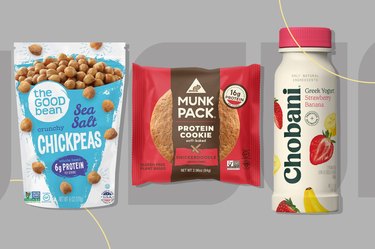
While everyone has their go-to, on-the-go bites for busy days, there's one snack option you've likely overlooked (or possibly never heard of) that ticks off all the right boxes: Fish jerky.
Not only does fish jerky provide a plethora of protein and omega-3s, but it's also low in saturated fat, among other health (and eco-friendly) benefits.
Video of the Day
Video of the Day
OK, but fish in the form of jerky? You might be wondering if it's fresh or overly fishy.
"In American culture, we are not accustomed to consuming seafood in preserved form (other than canned tuna)," says Kristy Del Coro, RDN, a registered dietitian and culinary nutritionist. And this can lead to a negative perception of fish jerky.
But first-rate fish jerky is made with fresh fish — it's just dehydrated (dried at a low temperature) to remove the moisture. "This process also locks in flavor, concentrates nutrients and extends shelf life, so that you can integrate high-quality, nutritious seafood more easily into your everyday life," Del Coro says.
Not convinced? Read on to learn why you should keep this shelf-stable snack on hand.
What Is Jerky, Exactly?
In general, jerky is any type of lean meat that’s been salted (to prevent bacteria growth) and dehydrated, Del Coro says. It’s usually found in stick or strip form and frequently made with meat that’s been seasoned with spice rubs or marinades (or sometimes smoked).
While beef jerky is the most common kind, jerky made with other animal proteins — like turkey, bison, elk and, of course, fish — are also becoming more popular, Del Coro says.
5 Reasons to Eat Fish Jerky
1. It’s High in Protein
"Protein is important for tissue growth and repair, building muscle and blood sugar regulation (especially when eaten with a carbohydrate-rich food)," Del Coro says.
Like other types of animal-based jerky, fish jerky is a splendid source of protein.
One ounce of fattier fish (think: salmon) has as much protein as one egg (around 6 grams) while leaner varieties of fish jerky (like pollock) offer upwards of 12 grams, Del Coro says. Leaner fish may even boast more muscle-building protein per serving than beef jerky.
2. It’s Rich in Omega-3s
"Fish jerky made from fatty, oily fish such as salmon and trout is a great way to get omega-3 fatty acids," Del Coro says.
A type of polyunsaturated fat, omega-3s support brain, heart and eye health. Plus, thanks to their anti-inflammatory properties, they are linked to promoting overall disease prevention by combatting chronic inflammation, Del Coro says.
Seafood like fish jerky is abundant in EPA and DHA, two kinds of omega-3s that are more readily absorbed by the body than ALA, a form of omega-3s found in plant-based foods, she adds.
3. It’s Low in Saturated Fat
"Unlike beef and pork, fish is higher in good-for-you polyunsaturated fats and lower in saturated fats," Del Coro says.
And that's a major perk for your ticker as eating too much saturated fat can increase harmful LDL cholesterol levels, raising your risk of heart disease and stroke, according to the American Heart Association (AHA).
"If jerky is made with a lean white fish such as rockfish or pollock, the fat content may even be zero," Del Coro says.
If you're watching your fat intake, just be sure to read the nutritional label on the back of the package: Certain jerky brands use coconut oil in their recipe, which ups the saturated fat content, she says.
For reference, most people should aim to include no more than 5 to 6 percent of calories from saturated fat in their daily diet, per the AHA. That's about 120 calories (or 13 grams of saturated fat) if you eat 2,000 calories a day.
4. It’s a Solid Source of Vitamin D
"We need vitamin D to effectively absorb calcium and phosphorous for bone health," Del Coro says. "And there's also research that associates adequate vitamin D intake with cancer prevention," she adds.
But this vital vitamin is found in very few foods, and many of us aren't getting enough (about 35 percent of American adults have vitamin D deficiency, per the Cleveland Clinic).
The good news: "Certain types of fish jerky, especially salmon jerky, are excellent sources of vitamin D," Del Coro says.
5. It’s More Eco-Friendly Than Other Types of Jerky
If you're an eco-conscious consumer, fish jerky is the right snack for you. "Generally, seafood has a significantly smaller environmental impact compared with livestock," Del Coro says.
That said, a particular product's "carbon footprint will vary depending on the method of production, harvest, processing, packaging and shipping," she says.
"But even with these variables, swapping out beef and pork jerky for fish jerky is going to be a more environmentally friendly option," she says.
Fish Jerky Brands to Try
Before buying fish jerky, Del Coro recommends reviewing the nutritional info. Specifically, keep these things in mind:
- Sodium. "Like all jerky, fish jerky can be high in sodium from the salt used to preserve the fish," Del Coro says. That means it's not recommended for someone on a low-sodium diet.
- Sugar. "Fish jerky can also be a source of added sugar from sweeteners such as maple syrup or brown sugar," Del Coro says. If you're watching your sugar intake, choose your product accordingly to avoid or limit excessive sugars.
Del Coro's picks:
- Pescavore Seafood Ahi Tuna Jerky Strip, Caribbean Jerk ($49.99 for a 10-pack on PescavoreSeafood.com)
- Neptune Wild Alaska Pollock Fish Jerky, Sweet Citrus Ginger ($8.99 on Amazon.com)
- Epic Jerky Bites, Wild Caught, Maple Glazed & Smoked Alaskan Salmon ($9.93 on Amazon.com)
- Kaimana Wild-Caught Ahi Tuna Jerky, Teriyaki ($29.99 on Amazon.com)
- Vital Choice Wild Salmon Jerky Strips ($39.99 for a 6-pack on VitalChoice.com)
How to Make Homemade Fish Jerky
Prefer to prep your own fish jerky in the comfort of your kitchen? We got you.
Making homemade jerky is a smart strategy as you can control the ingredients like salt and sugar and eliminate other additives like food coloring and chemicals.
For nutritious, flavorful fish jerky follow these step-by-step instructions, per Del Coro:
- Select your fish of choice (salmon, trout, tuna or whitefish are all wonderful options).
- Slice the fish (skin and bones should be removed). Aim for 1/2-inch-thick slices that are 3 to 4 inches long.
- Marinate the fish for about 2 hours in the refrigerator in a marinade of your choice. For a mouthwatering homemade salmon marinade, combine soy sauce, brown sugar or maple syrup and a touch of lemon juice. The marinade should be a tad more salty than sweet.
- After 2 hours, remove the fish from the refrigerator and remove or strain the marinade. Pat the fish dry with paper towels.
- Dehydrator method: If using a dehydrator (an appliance that slowly dries
foods at a low temperature), place fish on trays and dehydrate for 2 to 3
hours (based on instructions from the manufacturer).
Oven method: If using an oven, preheat to the lowest setting (around 170 degrees Fahrenheit) and spread the slices on sheet trays with racks. Slowly bake for 2 to 3 hours or until fish is cooked through (i.e., dried but still chewy).
Was this article helpful?
150 Characters Max
0/150
Thank you for sharing!
Thank you for your feedback!


